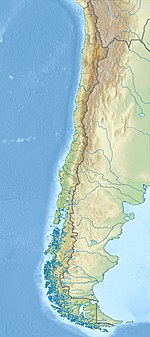Cura-Mallín Group
| Cura-Mallín Group Stratigraphic range: Upper Oligocene–Middle Miocene Colhuehuapian-Laventan (SALMA) | |
|---|---|
| Type | Geological group |
| Unit of | Cura-Mallín Basin Neuquén Basin |
| Sub-units | Various schemes, see text |
| Underlies | Trapa Trapa Formation |
| Overlies | Cretaceous granitoids Jurassic sediments |
| Thickness | >1,800 m (5,900 ft) |
| Lithology | |
| Primary | Sandstone, siltstone, shale, breccia, andesite lava |
| Other | Grainstone |
| Location | |
| Coordinates | 37°42′S 71°12′W / 37.7°S 71.2°WCoordinates: 37°42′S 71°12′W / 37.7°S 71.2°W |
| Approximate paleocoordinates | 38°18′S 66°24′W / 38.3°S 66.4°W |
| Region | Araucanía & Bío Bío Regions Neuquén Province |
| Country | |
| Type section | |
| Named for | Mallín |
 Cura-Mallín Group (Chile) | |
Cura-Mallín Group (Spanish: Grupo Cura-Mallín) is a heterogeneous group of volcano-sedimentary formations of Oligocene-Miocene age, Colhuehuapian to Laventan in the SALMA classification, in south-central Chile and nearby parts of Argentina.[1][2][3] The sediments belonging to the group were deposited in a lacustrine environment and alongside rivers in an intra-arc basin.[1] Southeast of Laguna del Laja Cura-Mallín Group has a thickness of more than 1,800 metres (5,900 ft).[4] The sediments making up the group deposited in an interval between 22 and 8 million years ago.[3]
The Cura-Mallín Group has a north-south elongate form.[4] The group is considered an equivalent of Abanico Formation, either as a southern extension or as a lateral equivalent of that formation.[4]
Stratigraphy and members[]
Various subdivision schemes have been proposed for the Cura-Mallín unit since the 1980s. In 1983, Niemeyer and Muñoz identified two members; the Río Queuco Member, overlain by the Malla Malla Member. In two publications published in 1995 and 1997, Suárez and Emperan divided Cura-Mallín Formation in two diachronous members: Guapitrío and Río Pedregoso. Utgé et al. (2009) proposed instead a subdivision into an upper Arroyo Pincheira Member and a lower Lumabia Member.[2]
In a 2017 revision the Cura-Mallín, formerly a formation, was redefined as a group given its great variety of lithologies.[3] The Guapitrío, Río Pedregoso members of Suárez and Emperan became formations according to this scheme. In addition the new scheme include the that overlies both the and as a third formation in the group.[3]
Cura-Mallín Basin[]
A number of geologists consider Cura-Mallín Basin, the sedimentary basin where the formation deposited, an extensional basin that developed on the western fringes of the much larger Neuquén Basin, while others consider it a back-arc basin. In the Upper Miocene the sedimentary basin was inverted.[5] Relative to other nearby sedimentary basins of Miocene and Oligocene age Cura-Mallín Basin has been more researched.[6]
Fossil content[]
The group contains abundant mammal fossils including bony fishes, birds and mammals such as rodents, marsupials, Mylodontidaes and Notoungulatas.[4]
| Group | Fossils | Notes |
|---|---|---|
| Mammals | , , , Caviomorpha indet., Dasypodidae indet., Typotheria indet. | |
| Paedotherium minor, , , ?Hegetotherium sp., , , , , , cf. Protypotherium sp., , , Astrapotheria indet., Astrapotheriidae indet., Caviomorpha indet., Dasypodidae indet., Eocardiidae indet., , , , Toxodontidae indet., Typotheria indet. | ||
| , , , , Protypotherium sp., , Echimyidae indet. | ||
| Fishes |
Economic geology[]
The proximity of the Cura-Mallín Group to the stratovolcanoes of Tolhuaca and Lonquimay has made it a reservoir of geothermal energy of interest. Of all units the Rucañanco Member of Guapitrio Formation has been judged to have the most promising reservoir potential.[3]
References[]
- ^ a b Suárez & Emparan, 1995
- ^ a b Utgé et al., 2009
- ^ a b c d e Pedroza et al., 2017
- ^ a b c d Flynn et al., 2008
- ^ Radic, 2010
- ^ Franzese et al., 2011
- ^ Cerro los Pinos at Fossilworks.org
- ^ Trapa Trapa East mid-upper beds at Fossilworks.org
- ^ Estero Trapa Trapa West at Fossilworks.org
- ^ Shockey et al., 2012
- ^ Flynn et al., 2008, p.414
- ^ Cerro Rucañanco at Fossilworks.org
Bibliography[]
- ; ; ; ; ; , and . 2008. Chronologic implications of new Miocene mammals from the Cura-Mallín and Trapa Trapa formations, Laguna del Laja area, south central Chile. Journal of South American Earth Sciences 26. 412–423. Accessed 2017-10-20.
- ; ; ; , and . 2011. Superposición de cuencas extensionales y contraccionales oligo-miocenas en el retroarco andino norpatagónico: la Cuenca de Aluminé, Neuquén, Argentina. Andean Geology 38. 319–334. Accessed 2016-08-01.
- ; ; , and . 2017. Stratigraphy, sedimentology, and geothermal reservoir potential of the volcaniclastic Cura-Mallín succession at Lonquimay, Chile. Journal of South American Earth Sciences 77. 1–20. Accessed 2019-02-15.
- . 2010. Las cuencas cenozoicas y su control en el volcanismo de los Complejos Nevados de Chillan y Copahue-Callaqui (Andes del Sur, 36-39°S). Andean Geology 37. 220–246. Accessed 2016-07-31.
- ; ; ; , and . 2012. New leontiniid Notoungulata (Mammalia) from Chile and Argentina : comparative anatomy, character analysis, and phylogenetic hypotheses. American Museum Novitates 3737. 1–64. Accessed 2019-02-15.
- , and . 1995. The stratigraphy, geochronology and paleophysiography of a Miocene fresh-water interarc basin, southern Chile. Journal of South American Earth Sciences 8. 17–31. Accessed 2019-02-15.
- ; ; , and . 2009. Geología del sector norte de la Cuenca de Cura Mallín en las Lagunas de Epulaufquen, Neuquén. Revista de la Asociación Geológica Argentina 64. 231–248. Accessed 2017-10-01.
- Geologic groups of South America
- Geologic formations of Chile
- Geologic formations of Argentina
- Miocene Series of South America
- Oligocene Series of South America
- Laventan
- Colloncuran
- Friasian
- Santacrucian
- Colhuehuapian
- Neogene Chile
- Paleontology in Chile
- Geology of Araucanía Region
- Geology of Biobío Region
- Geology of Maule Region
- Geology of Neuquén Province
